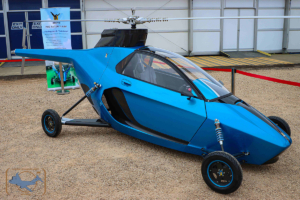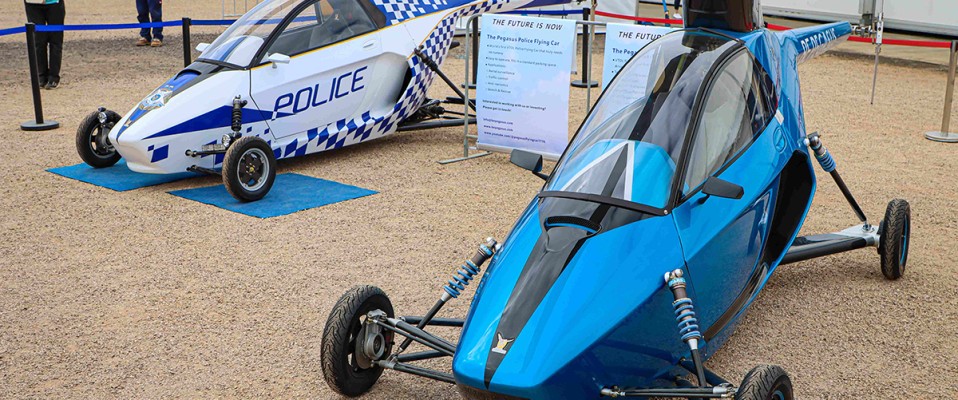Driving the Flying Horse.
Pegasus International unveils their flying car at Avalon with production of a four seat variant to be rolled out at end of the year.
Article & Images: Ryan Imeson
Combining the designs of an rotary aircraft with a car is something that was thought to have been capable of only in ‘the future’. The likes of TV shows like “The Jetsons” and movies like “Back to the Future Part II” that showcased a flying DeLorean were thought to be of as pure science fiction, and depicting in these flying cars as was something that would only happen the distant future.
But what if as Pegasus International says, the future is indeed now? Once considered nothing but a dream, the Australian-based company have now turned that vision of flying cars around city landscapes into a reality.
Located in Melbourne, Pegasus International have designed and produced what they call the Pegasus E, which is a hybrid car/helicopter driven on the roads like a car, but can also be flown in the air. No runway required, the ‘E’ is what is known as a driveable VTOL (vertical take-off & landing) Flying Car, the only one of its type in the world.
The Pegasus E certainly turned heads at the Australian International Airshow. Two models of the revolutionary design were present for the duration of the show, one in a civil aviation configuration, and the other bearing the markings of a police vehicle.
Built from advanced composite materials, the ‘E’ weighs in (dry) at a staggering 585 pounds, or 265 kilograms. During drive mode, a top speed of 120 km/h is possible, making it easily suitable for Australian roads. Using electric drive to power the road powertrain, the Pegasus will travel approximately 75km on one battery charge, making it ideal for short drives, with flight mode being the predominant feature.

With the push of a single button, the Pegasus E will transform from car to aircraft in three seconds. From there, a ceiling of 5900 feet in altitude can be achieved, travelling at speeds of up to 160 km/h. More comfortable cruising at 130 km/h, you can expect to fly for around 3 hours, using 20 litres per hour of Unleaded 95 fuel.
APD was lucky enough to have a chat with Pegasus International CTO and Test Pilot Jacky Yang at the Australian International Airshow (AIA). Jacky spoke about just what is required to operate a Pegasus E Flying Car.
“It requires at least an RPL helicopter license to operate in the sky. It works in the current airspace regulations, so people with the helicopter license can use it straight away”.
Visitors to the AIA would have noticed the police scheme on one of the flying cars. Jacky told APD about the potential that the flying car has for police forces, or other special departments.
“Picture an accident on the West Gate Bridge. Using the Pegasus Flying Car, there is no one else that can get there faster or more effectively. The best thing, it costs $140 per hour to operate, compared to the Victoria Police helicopter which costs $4000 per hour (to operate)”.
Cutting travel time is a high priority for most of us, and the Pegasus Flying Car has been designed to do just that.
“We calculated that if a car trip takes about one hour, it takes only fifteen minutes on the Pegasus Flying Car, so it’s absolutely great in that perspective”.
Formally announced at the AIA, the end of 2023 will see production of a four-seat Air Taxi prototype completed. Aimed at passenger transportation and logistics purposes, Pegasus believes their products will provide superior passenger and freight transport for large events.
“We want to be supporting the 2032 Brisbane Olympics. They had an idea about using eVTOL (electric vertical take-off and landing) vehicles for passenger transportation”.

Advanced air mobility solutions will play a key role in making these Olympics a successful event, something Pegasus sees their Air Taxi and Air Logistics products going a long way to help doing.
“Air Taxi will become a network of services. We think the sweet spot is about 50-100 km in terms of distance. It gives the flying cars the ability to stretch its legs and get there faster, compared to a car. As soon as the infrastructure matches, flying cars will be a day to day thing like Uber”.
When in full production, the Pegasus Flying Cars will be similarly priced to a supercar, a reason they have been called the ‘Ferrari of the skies’. As mentioned previously, there is no requirement for a runway. Your flying car can be stored in any standard parking space as well as a garage.
What was once seen as a product of the future, the Pegasus Flying Cars are now fully commercialised designs that can, and will be mass produced. They are one of two flying car manufacturers in the world that have been given national airworthiness certifications.
Pegasus is convinced that in the near future, ‘the opportunity to leverage three-dimensional space to alleviate surface congestion and capacity issues will lead to the establishment of networks of flying cars dedicated to critical activities such as rapid passenger transport, sensitive freight delivery and emergency response’.
For more information on these incredible vehicles, head to www.bepegasus.com
APD wishes to thank Jacky and Debbie of Pegasus International for their generous time in discussing what is inevitably a product we will be seeing a lot more of going forward.


